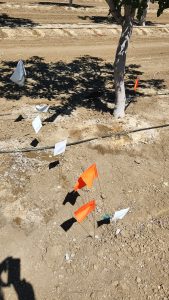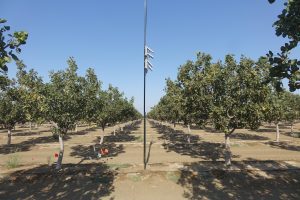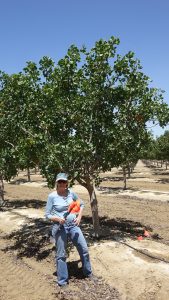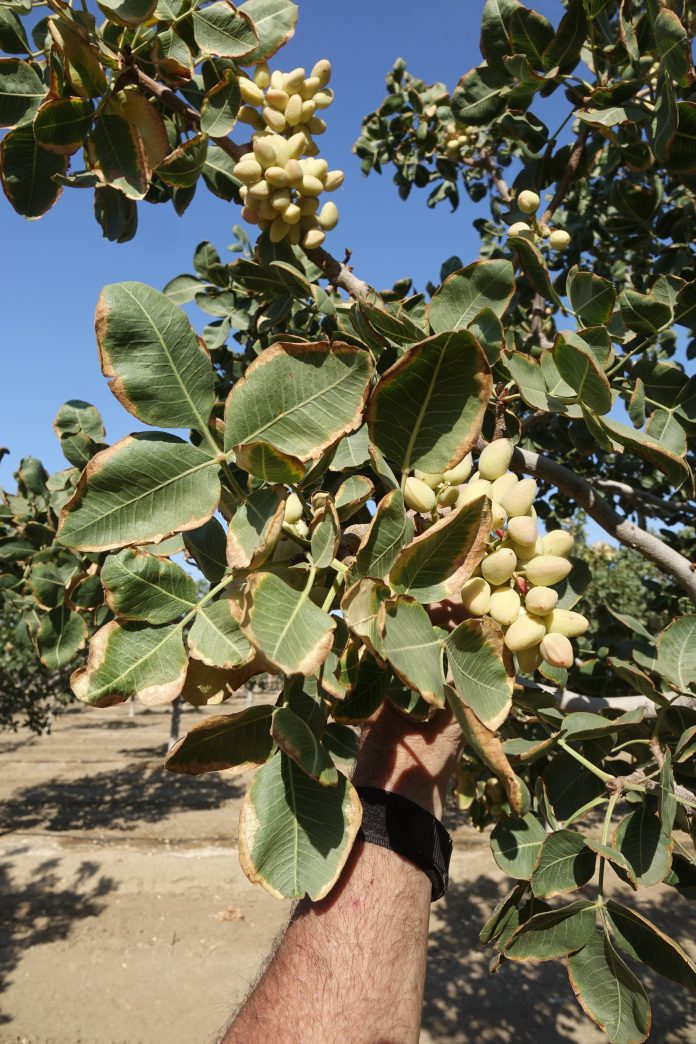Growers, crop managers and advisors packed the meeting room at the UC Kearney Ag Center in December for a salinity management workshop to learn more about addressing the problems salinity in soils and water is bringing to many in the pistachio industry.
California is the top producer of pistachio nuts in the U.S., but relative to other tree nut crops, pistachio is a new crop in California. The number of producing acres has grown steadily in the past two decades up and down the Central Valley, pushing many pistachio orchards into marginal soils.
A 2019, California Water Research Report noted 51% of Merced, 36% of Fresno, 89% of Tulare, 66% of Kings and 55% of Kern counties’ soils range from moderate (4 dS/m) to extreme (16 dS/m) salinity; dS/m is a measure of electroconductivity in soil. Of California’s 408,766 bearing pistachio acres in 2019, 380,642 acres are in these counties. A review of the Central Valley-Salinity Alternatives for Long Term Sustainability (CV-SALTS) progress report verifies salinization will continue to increase.
Workshop speakers said most soil salinization in pistachio production areas results from saline irrigation water and poor irrigation management, though growers have also been establishing orchards in increasingly saline soils.
Soil salinity becomes a problem in crop production when the concentration of soluble salts in the root zone is at levels high enough to impede optimal plant growth. The higher the concentration of salt in a solution, the higher the electrical conductivity (ECe) in dS/m. Plant tolerance can be related to the ECe value in a saturated soil sample. Workshop speakers identified a ECe of 7 to 7.5 dS/m as the threshold where pistachio tree health and yields will be affected, though it is generally recommended to maintain the ECe below 5 to 6 dS/m.
All attendees received a USB key with multiple resources and the UC ANR Press publication #33455 “Agricultural Salinity and Drainage,” which explains that the process of evapotranspiration concentrating salts in the soil. While pure water is transpired from leaves, the salt taken up by the plant is low relative to the native salts in the soil and those added by irrigation water. The salinity in the root zone increases due to the evapoconcentration process driven by ET. The soil salt concentration continues to increase if salts are not leached out of the root zone.
Drought, Salinity Effects Similar
While pistachio trees are more salt tolerant than many other orchard trees, the effects of salinity on pistachio yield are similar to those of a drought, said Giulia Marino, UCCE orchard systems specialist at Kearney. However, she noted, the effects of high salinity are much less reversible. Effects of salinity depend on the ion(s) present, primarily sodium, chloride and boron in the soil and water. Of the three, sodium and chloride contribute the most to salinity; the contribution of boron to total salinity is negligible. The ability of the rootstock and the scion variety to exclude, transport and sequester these three ions also determines the salinity tolerance of specific rootstock/ion combinations. For example, current research by Craig Kallsen and Dan Parfitt is demonstrating the boron-sensitive scion Golden Hills is having less boron concentration when grown on hybrids of P. vera and P. integerrima versus when grown on seedling or clonal UCBI rootstocks.
The first effect of soil salinity is osmotic. Because the salt concentration in the soil is higher than that in the roots, the roots take up less water. This “osmotic pressure” decreases water uptake. Therefore, less water is available to the plant to maintain the open stomata that ensure the photosynthesis that produces the carbohydrates that support growth and nut production. However, the effects of decreased water uptake do not manifest in stem water potential measurements until midseason.
The second effect of soil salinity is “specific ion damage,” manifesting as leaf damage caused by the components of salinity: sodium, chloride and boron. Currently, the so-called “boron toxicity, the brown dry margin on the mature leaves, is the visible ion damage identified in pistachio. Specific ion damage from sodium and chloride have not been identified. With all three ions, the levels of leaf analyses associated with decreases in yield have not been identified.
However, decreases in yield associated with total ECe, soil water extract and specific rootstock/scion combinations have been developed. Sanden, Kallsen and Ferguson demonstrated yields of Kerman scions on seedling UCBI and PGI rootstocks decreased 1.4% and 3.2%, respectively, for every 1 dS/m increase in ECe over 6 dS/m.

Irrigation Management is Key
Salinity also affects soil structure. Khaled Ball, irrigation management specialist at Kearney, noted applying the right amount of water to meet crop requirements, timing of irrigation events and applying the water uniformly are important in salinity management in pistachios.
“Get to know your soil,” Ball advised. He said soil physical properties and infiltration rate in an orchard site should be considered when designing an irrigation system and in managing irrigation. That includes consideration of soil spatial variability and texture when measuring infiltration rate and designing irrigation systems.
He noted that when dealing with salinity, crop water use is impacted, and applying the right amount of water to optimize profit saves water, energy, nutrients, and reduces GHG emissions.
In poor-quality irrigation water situations, Ball said adding excess irrigation water puts more salts in the root zone. At 1,000 ppm salts, one acre-foot per acre can equal application of 1.37 tons of salt per acre-foot per acre. Ball said salinity impact on crop water use in excess of threshold level reduces water use by the tree.
Among the considerations for salinity management decisions, Ball said, are soil aggregation, soil health, soil infiltration rate and pore space. Leaching can be done with sprinkler or flood, but efficiency and design to apply water in excess of rootzone storage is necessary. Leaching an entire orchard may not be necessary if a salinity map or soil samples do not show a need.
Infiltration problems in orchards can be physical due to soil texture, resulting in compaction. Ball said cover crops, deep tillage or application of organic matter can improve soil structure. He noted that gypsum will not improve infiltration rate if soil is compacted and does not have salt issues. Gypsum will work to improve water infiltration if soil is saline-sodic or sodic. If salinity is high but has no issues with sodium, leaching will be sufficient if the infiltration rate is good.
Adequate irrigation of pistachio trees in saline conditions will depend on infiltration and drainage. Mae Culumber, UCCE nut crops advisor in Fresno County, said irrigation water greater than 5 to 6 dS/m may not be sustainable for long-term productivity if salinity challenges are coupled with poor drainage. Soil and water chemistry and soil structure must be managed to improve drainage and leaching.
Culumber noted that fertilizer interactions with irrigation water can be problematic. Dissolved fertilizers react with water to form precipitates that can clog emitters. Fertilizer interactions can also be problematic. Naturally occurring calcium or calcium amendments applied to the soil can cause calcium carbonate to precipitate and increase clogging in irrigation lines. Evaporation and increasing temperature increases insolubility of calcium carbonate.
Microirrigation systems can be highly efficient, but Culumber said many will have varying distribution uniformity across the black. Untreated water quality problems will make the problem worse. Regular maintenance along with annual water analysis is recommended.

Leaching Salts
Culumber said without leaching, elevated salinity levels will eventually lead to increased salt uptake, specific ion toxicity and degraded soil structure, which further compounds tree root stress with drainage problems. She cited a 2016-19 UC study to measure ET and Kc of well-watered pistachio trees grown on non-saline and increasingly saline soils. They found that salt-affected soil resulted in smaller canopy size and lower yields and a 10% to 30% lower water use. Water use efficiency and productivity relative to the non-saline orchard decreases as the EC dS/m increased. Despite lower water in-season requirements, additional water is needed to leach salts from the rootzone during dormancy.
Culumber noted that irrigation scheduling tools will increase precision and manage tree stress in saline conditions. Soil moisture monitoring and water budgeting can lead to improved irrigation decisions on frequency and duration.
One of those tools is CropManage. CropManage is an online UC resource to schedule and track irrigation applications throughout the year.


Cecilia Parsons | Associate Editor
Cecilia Parsons has lived in the Central Valley community of Ducor since 1976, covering agriculture for numerous agricultural publications over the years. She has found and nurtured many wonderful and helpful contacts in the ag community, including the UCCE advisors, allowing for news coverage that focuses on the basics of food production.
She is always on the search for new ag topics that can help growers and processors in the San Joaquin Valley improve their bottom line.
In her free time, Cecilia rides her horse, Holly in ranch versatility shows and raises registered Shetland sheep which she exhibits at county and state fairs during the summer.
















